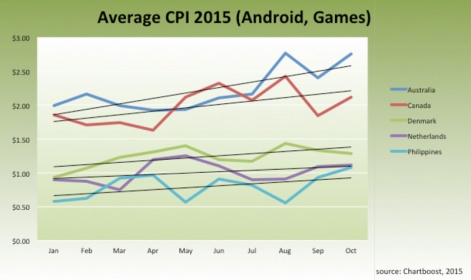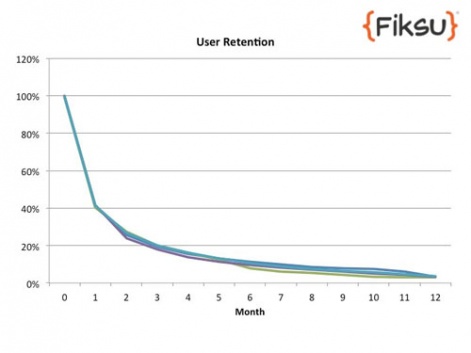Torulf Jernström is CEO of Finnish developer Tribeflame.
His blog is Pocket Philosopher.
Following last week's article about free user acquisition, this week, let's go into what you can do to get users with money - paid user acquisition.
Again, this is the broad overview of what is useful to know for an indie developer just transitioning into paid UA, not an in-depth article on all the details.
First, let's get the simple and modest message about PR out of the way.
You should probably do PR, but don't expect much from it unless you are one of the top games companies around and people have been waiting for news about what you're about to do next.
Supercell's announcement of finally launching Clash Royale as their fourth game - after years of simply slaughtering games that were good, but not insanely great - is considered global news.
For the rest of us, sending out a PR message is unlikely to move the needle on downloads. It's sort of the same thing as with fishing for earned media by talking to press, etc.
Influence the influencers
Another way to gain paid visibility is to 'bribe' YouTube content creators to do a video about your game.
There are a lot of creators who are primarily making videos about games. The biggest YouTube star of them all, PewDiePie, started out by mostly making videos of himself playing games.
Of course, these guys will make a video about your game out of pure interest in case they find your game interesting. Otherwise, you can, as I said, pay some of them to do it.
The YouTubers have people who follow their channels. This is the main metric their agents will quote if you want to buy their services.
Someone with about half a million followers might get 10-50,000 views per video.
It does not mean that your video will be watched by that many people. Just that that number of people will be notified about the new video being posted, after which some of them will decide to watch it.
Beware big numbers
As I said, PewDiePie has the largest number of followers at some 42 million. Some fairly large other YouTubers have single-digit millions of followers, and quite a lot of them have hundreds of thousands of followers.
A typical PewDiePie video might be watched by some 2 million viewers, while someone with about half a million followers might get 10-50,000 views per video.
If you are interested in getting downloads, you then need to have a guess at what percentage of video viewers will convert into game downloads.
Usually, that's not a whole lot, honestly - even though being played by PewDiePie was, according to legend, one of the things that fed the Flappy Bird phenomenon.
You can watch that video below:
However, if you look at the Top Downloaded chart for Flappy Bird, you'll see that it had been at number 1 for some weeks already on January the 27th, when that PewDiePie video was posted.
Standard techniques
On to some more mainstream ways of acquiring users.
I've already written a few articles about ad networks.
They are the usual suspects when it comes to acquiring users, and there's quite a number of them: Ad Colony, AdMob, Chartboost, Unity Ads, Millennial Media, Supersonic, Facebook, etc.
Mainly, they will show your ads in other (free) apps, with a link to your App Store page.
There are several types of ads:
- Banners are similar to what you find on webpages were some of the first ones to move over to mobile. They have largely gone out of fashion by now, as they don't work for anyone. They annoy the player, don't work for the advertiser and make no money for the game that shows them. Just skip these.
- Interstitials are full-screen ads (pictures) that will appear between play sessions. They work a lot better than banners, but not quite as well as the trend now, which is video ads.
- Video ads are the mainstream marketing tool by now. They are typically about 30 seconds long, and either shown in between play sessions without anyone asking for it, or, preferably, when the user asks to see one in exchange for some in-game benefit - called incentivised video ads.
- Native ads is a hyped term that basically means that the ad network does some work to make the ad fit in with the game's overall style.
These ad spaces are then sold in a form of auction. That means that you do not typically negotiate much regarding pricing.
You simply set what you want to bid, and an automated system takes care of it. The higher you bid, the higher your placement and thus the more visibility you will get.
Different ad sources are likely to vary wildly in the cost you have to pay for a download.
CPI (Cost Per Install) is the typical way you will compare the cost between different channels, even if what you are not necessarily paying for installs, but might be paying for views (CPM, Cost Per Mille, that is per thousand views).

As I wrote in a previous article, the difference in CPI between two ads can easily be a factor of 10. Some installs cost us over $5, while others were under $0.50.
An expensive install will be over $5, while anything below $1 is considered cheap by now.
It obviously also depends on the country you are advertising in. Some of the most competitive markets are much more expensive than developing markets.
What your most direct competition is bidding will also affect what you need to bid.
Of course, it does not make much sense to pay for a download in a market where you know that the players will never have money to pay for anything in the game. That is, their Lifetime Value (LTV) is very low.
Another thing that affects the price is the volume you want to buy per day.
It is much cheaper (per install) to buy lower volumes. The higher the volume you want to drive per day, the more you have to pay for each install. That auction system basically forces you to bid high to reach volumes.
What your most direct competition is bidding will also affect what you need to bid.
If two games are targeting the same potential players, the one who can afford to bid higher will win and crowd out the other one. That's a very good reason for you not to clone Clash of Clans or Game of War!
To have a look at what other's are spending, head over to Appscotch.
Which countries?
A lot of companies are targeting the US first.
There are two reasons for that. One is that the US is the top revenue generating country (together with Japan and Korea).
The other is that trends from the US often spread to other markets, and more seldom the other way around.
This is similar to the music industry: while every country has their own charts, Germans will hear about a band that tops the US charts, while Americans will certainly not hear about a band that tops the German charts.
Speaking of charting, that was a very popular strategy early on for the App Store and Google Play. They gave a lot of space to the Top charts, which led a self reinforcing spirals for the most successful apps.
A burst campaign is one specifically designed to get the app to rise up the charts, without much care for the quality of customers attracted.
Apple and Google have changed the stores since then, and now the self reinforcing spirals are not as strong anymore.
Can you burst through?
A "burst" campaign is one specifically designed to get the app to rise up the charts, without much care for the quality of customers attracted.
The hope is that the app will benefit simply from the exposure it get by being high on the top downloaded chart.
The cheapest way to get there is through 'incentivised' installs. That is, to bribe a player with some items in one game, in order to get them to install another game.
Most people who install through such an offer will hardly ever open the target app, and their retention in that app is dismal.
They are cheap though, and can cost from a few tens of cents to about $1.50. As with all other ad prices, they are cheapest in Q1 and most expensive during the Q4 holidays.
This way of gaming the App Store and Google Play is not really popular with the platform holders.
They have therefore limited its appeal by giving less visibility to the top charts, by calculating the top charts based on more than simple downloads (counting retention, ratings, etc. on Google Play), and by outright banning incentivised installs (App Store).
If you still want to use the burst strategy, it's best to concentrate your firepower to select markets and likely either iOS or Android. With incentivised installs, you only benefit if you get into the top 10. Otherwise you are wasting your money.
Valued downloads
The retention and monetisation of players will be different depending on where they come from.
Roughly speaking, the more they know about your game before downloading, the more probable it is that they will actually enjoy it and stick around.
People who have seen a video with gameplay explained will likely show good retention. People who download a game their friend showed them will also stay.

The downloads you get from getting featured are slightly worse, while banner ads and especially incentivised downloads can be really bad.
Since this is quite complicated, with varying cost levels together with varying value for the customers acquired, there are several companies that specialise in it so that you can outsource the trouble.
It will typically cost you around 10% of your ad budget. The quality you get really then depends on how important your business is to them, and how much attention you will therefore get from the "ad ops" - the guys who are running the optimization.
A helping hand
Speaking of budgets, when you do low volume paid UA, you are likely to just buy it with your credit card through an automated system. That will become a problem very quickly once your volumes go up.
Most credit cards have their credit limits at some thousands of euros/dollars/pounds, and the UA budgets quickly rise above that. You will have to ask for credit with the ad networks to get around that.
One interesting way to stretch your budget is provided by a company called Pollen VC.
Buying ads at even moderate scale will quickly tie up a lot of money.
Buying ads at even moderate scale will quickly tie up a lot of money. Say you're buying installs for $10,000 per day, and you're so incredibly lucky that they players immediately spend an equal amount in the game - that is, everyone customer you acquire is immediately profitable.
Apple and Google will pay you with a small delay, and that delay still needs to be financed.
At $10,000 per month, you need about half a million to buy ads before you start getting your money back from Apple and Google (45-60 day delay at $10,000 per day).
Pollen VC looks at your accounts on the App Store and Google Play, and then lends you the money the next day - a handy tool when scaling up a game company.
Last, if you want to become an expert in this field, you should follow blogs such as Eric Seufert's MobileDevMemo, and attend conferences such as The Business of Apps.





















